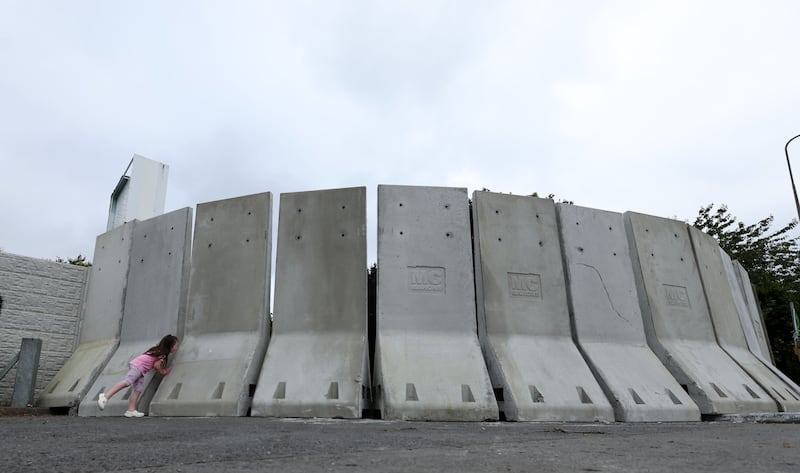Last Wednesday afternoon, following two days of serious unrest and dozens of arrests at a nearby site earmarked for asylum seekers, teenage boys sitting on a low wall in the Belcamp area of Darndale watch curiously as The Irish Times approaches.
A woman in the doorway of the adjacent house nods a greeting, looking on as reporter and photographer explain who we are – that we’re asking young people their thoughts on the disturbances at the former paint factory on the Malahide Road.
Riots, which erupted following the clearance of a camp established four months ago to protest plans to accommodate 500 asylum seekers there, included a digger being set alight, petrol bombs thrown, pepper spray used on rioters, and deployment of the Garda Public Order Unit.
One boy aged about 15 gets to his feet with a smile, saying: ‘No, [he] wasn’t there ... F**k that – you’d end up getting arrested” – but he saw it all on TikTok. “Madness, wasn’t it? Like World War Three.”
READ MORE
Suddenly, he stops. “Hold on. Hold on a minute. Yiz aren’t coppers, are yiz?”
Others stand too, zipping their jumpers up around their faces, pulling hoods over their heads. One walks away.
“You’re not videoing this?” asks another.
Despite reassurances that we are neither filming nor recording, and are not gardaí, they are clearly nervous. They don’t engage further.
One gestures towards some older men across a rubbish-strewn green, past two boarded-up houses, saying: “I think they were at the protests.”
Around the neighbourhood are eight-metre-high poles topped with CCTV cameras: a constant reminder that the vast area, which also includes well-kept greens and baskets of pink flowers hanging from lamp-posts – is under permanent surveillance.
Less than 3km away, at the entrance to the disputed site, are more young people. Two teenage girls sit on camping chairs looking at phones among about a dozen people maintaining a ‘picket’.
One, an elderly man, is happy to talk to a journalist. He will protest for an hour before going for his shopping, he says.
“I am past my sell-by date now, but I have a grandson and he is living in his partner’s family house, in a log cabin. He has two children. He is saving hard to get a house. I’m here for them. There’s people coming into the country being handed everything, everything. Where is the fair system?”
Watching our conversation is former local election candidate Kevin Coyle. He interrupts, saying that a question on the housing crisis “can’t” be put to the man. He calls this writer a “snakey, two-faced c**t” adding derogatory terms for The Irish Times.
“Everybody hates you around the country,” he says. “The same with the people in Coolock.”
He is then joined by a woman directing The Irish Times to “leave” the public path. “Yiz are getting nothing,” says Mr Coyle. The interaction is filmed by one of those present.
Whether present or not at the recent disturbances, the children and young people of Coolock and Darndale can witness every frame, including disturbing violence, on social media.
“We’re extremely concerned [about the impact on children and young people],” says Ashley White, communications co-ordinator with Sphere 17, a regional youth service with centres in Bonnybrook, Priorswood, Kilbarrack and Darndale.
“Our priority at the moment is the welfare of our young people. We have been adapting our service provision and summer programme plans in an attempt to provide additional support to the young people who need it.”
On Monday evening, when large numbers of people arrived into the area to both watch and participate in the rioting, the service moved quickly to take the young people attending the service that evening out of the area.
Among those caught up directly in the chaos was Luna (15, not her real name) who has lived all her life in Darndale. “I was trying to walk towards Northside [shopping centre]. I was terrified. At any given moment, I thought people were going to come up, hit me. People were fighting. I took off running, I was so scared.”
Speaking to The Irish Times at a local Sphere 17, Luna says she has been aware of the ongoing protests since March against the planned new use for the Coolock site. She understands people’s concerns. “They’re scared because [asylum seekers] are coming in and they don’t know much about it. I can see why there’s like public fear.”
Many of her friends, whom she “loves”, are “from other countries”, however. She adds: “Migration is rarely a choice.” She believes people coming to Ireland for refuge are “scared too”.

Luna has “big aspirations” for herself, including studying law at university. The violence of the past week upsets and frightens her. Not only does it reflect badly on her home – “I love Darndale. It gets a bad rap, but it’s a great place to live. The sense of community is so good ... It’s a really warm place” – but she worries that young people she knows could get caught up in the disorder. She also fears for her own safety.
“Since the riots kicked off, I am like: ‘I am not leaving my house’. I haven’t left Darndale unless I’ve been in a car. I won’t even walk over to the shop ... I’m very worried about people I know being pepper sprayed.”
As we speak, on Thursday afternoon, about 20 young people are at the centre – baking cupcakes, making arts and crafts and playing pool. It’s a calm and happy scene in the bright, well-equipped space that engages with over 1,000 locals, aged 10 to 24, each year.
Despite her youth, Luna succinctly expresses sentiments echoed elsewhere, by community leaders and public representatives, that local people – particularly the young – will likely pay the heaviest price for the breakdown in public order.
A perceived lack of genuine consultation – listening, explaining and taking on board the community’s concerns – by the Department of Integration, which has leased the Coolock site, is brought up repeatedly by people when asked about the anger.
“At the heart of this, though, is poverty,” says Paul Rogers, chief executive of the Northside Partnership which co-ordinates funding and services addressing poverty across northeast Dublin. While the economy nationally has improved, deprivation has worsened across the most disadvantaged areas of Darndale and Coolock, he says, citing 2016 and 2022 Census data collated by the independent agency Pobal.
The small areas of Darndale where the teenage boys who spoke briefly to The Irish Times were sitting fell from the classification “very disadvantaged” in 2016 to “extremely disadvantaged” in 2022.
In one area, 27 per cent of adults have a primary school education only. Just 7.8 per cent have a third level education. Male unemployment is at 29.97 per cent and female unemployment 14 per cent, while 59 per cent of children are in lone-parent families.
Despite population growth, funding for many services remains below 2008 levels, Rogers says. The Social Inclusion and Community Activation Programme (SICAP) fund, the partnership’s main revenue stream, was cut from €66 million nationally in 2008 and has never recovered, while youth services like Sphere 17 are operating a 15 per cent funding deficit.
“Many of us who work in this community feel there has long been an unspoken policy of: ‘Let’s put the minimum into it to keep them quiet’,” says Rogers. “And that they don’t really care about working class communities like ours.
“I often wonder, for every young person that goes to third level, how much does the Government subsidise them? About €15,000 a year each? But the kids from around here, struggling the most to get anywhere in life, do they put that kind of money into them? No.
“What happened on Monday is reprehensible, but I am not surprised. There is a lot of anger. The State’s attitude to Coolock is: ‘This is happening whether you like it or not’. The migrant challenge has become a proxy for that anger.”
He does not feel it is “helpful” to describe angry young people as “thuggish”.
“They are members of our community whether you like it or not,” he says. “They may now have a criminal record. They are young people who will come to us at some stage. We will work with them.”
Like many, he believes a large proportion of the people involved in disturbances were not venting about migration policy. For some it was “recreational rioting”. For others it was general rage.
“As Martin Luther King said, rioting is the language of the unheard.”
As we finish, when asked if there is anything she wants to add, Luna says: “I want to say this. I want this rioting to stop because it’s got to the point now where businesses, like the cinema [across the road from the site], will close. I like the cinema. I want to see Despicable Me 4. I don’t want to lose the facilities where we go. [Everyone] needs to go about this situation better.”
- Sign up for push alerts and have the best news, analysis and comment delivered directly to your phone
- Join The Irish Times on WhatsApp and stay up to date
- Listen to our Inside Politics podcast for the best political chat and analysis



















